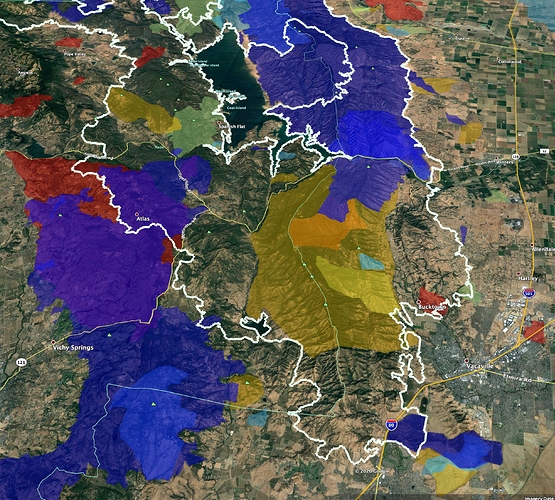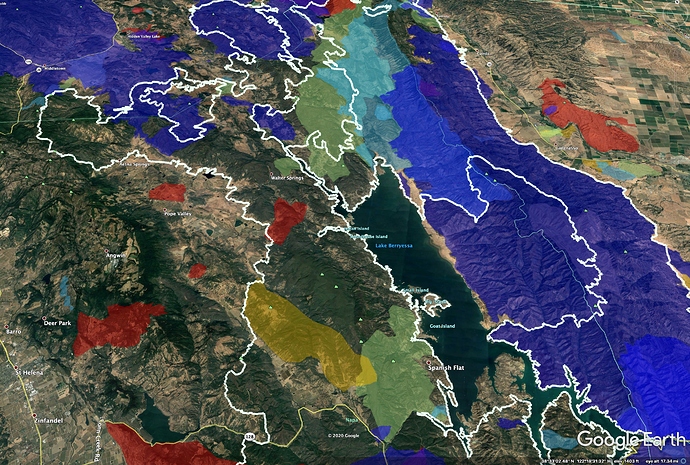Pyro and I have had this discussion not long ago. It IS a very complicated issue that is not easily solved.
Burnit, you are absolutely correct in your statements regarding the USFS. They have excellent FF’s and officers that have repeatedly confided in me they get extremely frustrated by management that has no fire experience whatsoever.
In cases like the MNF, it may be prudent to allow the fire to rip in the wilderness, but it still requires a resource commitment when resources are too thin and exhausted.
This conundrum of allowing a fire to rip in the wilderness during peak fire season has long been an issue. There are very few, and I mean very few locations in CA where a fire left unchecked to burn wilderness will not at some point impact people and infrastructure. ie…Zaca, Day (after day after day). These fires were in wilderness and got so big that the fires went where they wanted to and ultimately became a major interface issue requiring many, many resources to mitigate and prevent major destruction.
A major issue here as I have stated before is that the politics and environmental extremist groups with deep pockets have handcuffed both agencies to the point of ineffectiveness in years past.
Some politicians have seen the light, and by that I mean the light of thousands of homes burning, and allowed us some temporary reprieve from environmental hoops. This is where we need to seize the opportunity and do winter and shoulder season vegetation management burns and reduction when it needs to happen.
As a Chief Officer, I would never allow a fire to become a VMP during peak season. That is just poor management, poor safety, and asking for trouble.
And one final thought, peak and late season fires have extreme mortality in chaparral and timber. This is NOT recoverable without replanting and close care post fire. Just look at some late season fire scars and it is truly sad.
Give it some chance to work. Hopefully the recent changes will stick, but unfortunately we cant fix 30 years of environmental craziness.
The only comments I’d make are:
- About your use of the word ‘rip’ in describing fire behavior in the wilderness. This implies severe burning. The direct evidence from most of the large fires up there in past 20 years is that the large fires have had almost all low and moderate effects.
- Fires in the wilderness do require a resource committment, but depending on the incident complexity, it can be way lower than a suppression incident of similar size.
Fires in the Wilderness do not sty in the wilderness. The Eiler fire escaped control near the 1,000 Lakes and darned burned up Burney, the Reading fire escaped from Lassen NP and tried to burn Old Station.
Fire severity is is a nebulous term. The BAER team said that very little of Whiskeytown NRA suffered sever damage… we locals call it the Zone of Desolation.
Look at the Willow and Hopkins fires this afternoon…would you describe that as low to moderate ? I call it it ripping.
Just a thought on deferred risk.
I respect your perspective and experience. And you are totally correct that putting fires out quickly does reduce exposure of firefighters, in the immediate-term. I think we are just thinking in different time scales.
The fuelscape we have today, where a fire in LNU can rip 150,000 acres in two burning periods, is the result of our policies of total suppression. Every fire we succeed in keeping small adds acreage to our bank of overmature brush and down fuels. This is the gift our predecessors have handed to us.
I’ll be proud if my sons want to become hotshots ten years from now, but every fire we keep small between now and then amplifies the risks their generation will have to face.
Lake Napa Unit cannot be described as a fire exclusion area by anyone. The Knoxville Berryessa area has burned repeatedly for the last 60 years that I am aware of and the old timers tell me longer than that.
Your arguments completely disregard the premise of private property and the fact that 40 million people live in California and don’t want the air pollution and risk from escaped fires. We are simply not going to be able to burn our way out of this problem.
We need new thought… The USFS Land Management practices don’t work in this climate with this population density. Fires don’t respect administrative boundaries. The WUI is bigger than we think. The Carr fire taught us we can’t have a Whiskeytown Park breeding ground for conflagration next to a city. The Eiler fire taught us that phony wilderness land use policies are dangerous.
I just came in from looking at the August Complex as it burns a good portion of the Mendocino National Forest. This is unacceptable. We’ve got to change .
I have been silent on this matter but there are some things that need to be clarified with respect to the LNU Complex. I am a native of the Upper Napa Valley and travel the entire Hennessy Fire footprint regularly. The East of the Fire and the South end do burn on a regular basis, however, a solid 50% or more has not burned in a very, very long time and was extremely overgrown.
The reality is that there is no perfect solution to this problem. I am a firm believer that effective fuel reduction would have lessened the impact to Spanish Flat and the South end of the Lake structural losses. A good example is the FireWise measures that Lake Berryessa Estates community, which had tremendous strategic value in protecting the majority of that area. Fuel reduction is an ongoing and continuous exercise. It is not a one and done process.
Smoke dissipation or lack thereof is not really a valid argument. We are going to have smoke one way or another as Mother Nature has demonstrated over the past 2 1/2 weeks. Smaller chunks of preventative burning would have been generated a fraction of the smoke we are now experiencing with a million acres torching off at the same time. Additionally, lower intensity burns would not have the destructive factors to the soil composition and chemistry that these high intensity fires are at the moment. The entire ecosystems of these burn areas will be impacted including both flora and fauna.
What is key, is that what is effective in one area may not not be effective in another. Comparing the LNU Complex to the MNF is no where near comparable.
This discussion is not nor should be about an entire Statewide or comprehensive discussion.
LNU has had plenty of fire, without a doubt, but the initial run of the Hennessey Fire (white outline) was thru an area that hasn’t had any large fires since 1988, in orange here. The colored areas on map are fire history since 1980.
Farther north, Hennessey found plenty of ground that hasn’t had fire in 40 years.
For the record, I have never said I think we need to have a let burn program in LNU, or just about anywhere else that isn’t completely in the middle of nowhere. I worked on the Eiler Fire, and have seen the King Fire run 15 miles in a single afternoon. I agree with DozerKeith. All of our fire problems have their own geographies and unique challenges.
I’m on this fire and it’s definitely in the wilderness. And the lid came off the pot yesterday
I also live in Napa County and spent over 10 years of my career in LNU in Lake and Napa counties. The areas of the lake that haven’t burned in recent history was the west side of the lake. You are correct that the west side of the lake was overgrown but its also all private property. Other then 4291 regs around the structures, no one can force a landowner to cut their brush outside of 4291 regs. Through in the environmentalist and the extreme regulations on land clearing in Napa county and you have a recipe for disaster.
It wasn’t fuel reduction that save the estates it was the firing operation that kept the fire out of the estates. Fuel reduction is a loosing battle, guess what happens after you cut the fuel break? It grows back! In all reality fuel breaks are strategic location for firing operations, more so then to stop a fire. I have seen fire jump 10 blade lines and 8 lane highways, not much a shaded fuel break is gunna do to stop something like that.
150,000 acres in two operational periods has nothing to do with fuel loading. That massive fire movement was caused by strong outflow boundaries. Without the strong wind those fires wound have ran the ridge and went out, just like they always do, but you thrown in near hurricane force winds then the story is a little different.
Does anyone remember the quail fire from earlier this year? 1800 acres at quail canyon and pleasants valley road. Under the thought process proposed here those areas should have been fine, they had a moderate intensify fire burn through the area just a few months ago. Guess what happens in that area? Heavy structure lose.
Thinking we can get out of this situation by cutting some brush and burning a couple hundred acres here and there is nonsensical. We are not in this situation today because of failed fire policies. We are here because the extreme environmentalist in this state, people that cant get it through their heads that trees are essentially really tall weeds and just like at your house if you don’t trim your weeds your yard becomes overgrown. But hey you can’t see the forest from San Francisco so…
Until someone can show me some evidence to the contrary. I will continue to say this, the best way to attain safety for everyone on the fire is to put the fire out. The notion that we should let fires burn today for the firefighters of tomorrow is preposterous.
Mod Note: Unfortunately, it appears this topic can no longer be discussed civilly and will now be closed.


